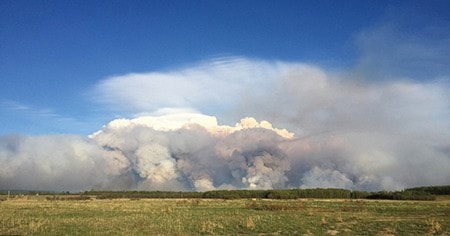In the wake of the Fort McMurray forest fires and increasing summer temperatures, Saanich Peninsula fire chiefs are warning residents that the local fire risk is already high.
“We’re at a high risk already very early in the season. Things are dry out there,” said Central Saanich Fire Chief Ron French.
He said there is definitely a risk, especially with interface fires in the Mt. Newton area.
Interface fires, which could be the most common type of fire on the Peninsula, is where housing and forested areas meet up.
French said with the tree canopy being so thick in the area, the rain doesn’t really get in and soak into the ground.
Sidney Fire Chief Brett Mikkelsen said they, too, have concerns with urban interface fires, but not to the same extent as those in Central Saanich or North Saanich.
“Of course Sidney has much less of what we would call urban interface fire risk than Central Saanich and North Saanich simply because of our geography…” he said.
The largest concerns firefighters run into in Sidney, he said, is careless people discarding cigarettes. Those have already been the cause of fires in hedges along the highway or grass areas.
In preparing for a potential serious fire situation, French said people should follow the Fire Smart Program, which is put out by the Province.
“We have copies of the manuals linked on our website. (People) can actually come into the fire hall and get one,” he said about the Fire Smart Program.
There is also lots of information on the Central Saanich Fire Department’s website, csfire.ca.
French said although there haven’t been any large fires lately on the Peninsula, area fire departments are still very vigilant in the summer months.
“We bring in the volunteers on the weekends to get a quicker response in the hotter months of the year,” he said.
“We’ve designed our equipment to have a fast attack for wild land stuff. We have a truck designed for wild land with phone capability which is a better extinguishing agent for wild land.”
Mikkelsen said Sidney Fire Department in the summer months also have a specialized truck available. He said they have a small wild land pump and a tank, specifically for quickly extinguishing grass fires and fires in little forested areas and parks. This is so that the team can get to the scene quickly.
When it comes to the high risk spots in Central Saanich, French said Mt. Newton would be their highest risk area as the houses are built into the forest. An evacuation spot in this case would be to head down to the Saanich Fairgrounds.
“It really depends on where the situation was, where we would direct people to go to,” he said.
French said they also have two First Nations in the area with treed areas within, so would likely also direct them to the Fairgrounds.
Mikkelsen said he isn’t too concerned about there being an urban interface incident in the Sidney area, adding local emergency services have dedicated reception centres in the various neighbourhoods to take in people displaced by fire, or in the event of a disaster.
“What we would do in the context if there was an issue — say there was something over in the west side of Sidney — we have dedicated reception centres in specific neighbourhoods that we would (activate) and have people respond to, depending on the location of the incident,” he said.
Mikkelsen was part of the contingent that went to the Okanagan Mountain Park fires in 2003 and has seen what can happen during interface fires.
“I’ve seen what can happen first hand in respect to wildland and urban interface fires, so I definitely have a respect for it.”
